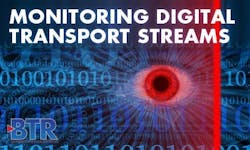Monitoring: Going Beyond the Standard
By Simen Frosted, Bridge Technologies
The standard itself does not encompass every aspect of performance necessary to the delivery of a stream, with certain behaviors and errors that can occur in a stream not falling within the tested parameters. ETR 290 is also complex, and the intricacies and subtleties are not always fully understood by operational staff. And there are some vital parts of a digital media service operation that are not covered by ETR 290 at all.
Challenges
Taking these points in turn, the gaps in the standard are inevitable to some degree in that technology is constantly evolving, and a standard represents an agreement reached at a point in time. Therefore, circumstances arise in operational practice that may not have been envisaged when the standard was first formulated.
Secondly, the complexity of ETR 290 is a necessity because streaming digital media is a complex business. But it means that the knowledge and experience necessary to use ETR 290 effectively are in short supply. Operators of digital media services have commercial imperatives to deal with, and in the real world, it’s not possible to find and employ enough highly experienced and knowledgeable staff to ensure that ETR 290-based monitoring is calibrated optimally for every stream.
And lastly, although ETR 290 was conceived to provide a framework for quality control of digital media streams, there are many other parts of a complete service that are outside the scope of ETR 290. The conditional access system (CAS) and electronic program guide (EPG) are examples of these, and malfunctions here have as big an impact on the subscriber as do errors in the digital stream.
So a monitoring strategy based principally on ETR 290 is only a partial and semi-satisfactory solution for service providers, and much can be done to improve the accuracy and value of monitoring systems by extending the scope of testing and analysis beyond the standard.
Possible answers
One response would be to make it easier and quicker for technical staff to calibrate ETR 290 checks appropriately for each stream. The proliferation of services and the pressure on staff time would make this alone a very helpful improvement. Then, if the monitoring system could also "fill in the gaps" in the standard by checking for error conditions that the usual ETR 290 parameters miss, so much the better. Add an ability to monitor service-affecting errors in language delivery, EPG and CAS, and you begin to have a much more useful monitoring capability in commercial and operational terms.
In any rapidly evolving field, the conventional approach quickly becomes overtaken by events. In fact, by the time a convention emerges, it usually represents a consensus on the state of play as it existed at some point in the recent past. Convention and obsolescence go hand in hand. The technology used to deliver digital media services is in continual flux and forward development, so while some standardization is necessary for interoperability, it is unrealistic to hope that standards will cover all the bases.
There is also what might be called conceptual standardization - or to put it another way, convergent thinking. Acceptance of the status quo is a normal human response to the need to find stability and certainty, and this tendency conditions our decision-making when confronted by something new. So if a certain approach to a technical challenge is perceived as "the way it’s done" because enough people do it that way, there’s a disincentive to search for a better way to tackle the challenge - or even to consider that there may be a better way.
It’s important for both manufacturers and buyers to bear this in mind, and also to avoid a complacent assumption that if a technology or system is "standards compliant" it automatically gets the job done in the best possible way. Given that a standard necessarily represents a consensus agreed at a point in time - essentially a snapshot of the past - buyers should be continually on the alert, asking themselves: "What developments have occurred since the standard emerged? And how does the technology I am considering deal with those developments?"
For manufacturers, the task is to look for ways to move beyond the conventional and produce solutions that are effective for in the real world that digital media service providers inhabit.
Simen Frosted is the chairman of Bridge Technologies. Reach him at [email protected].
